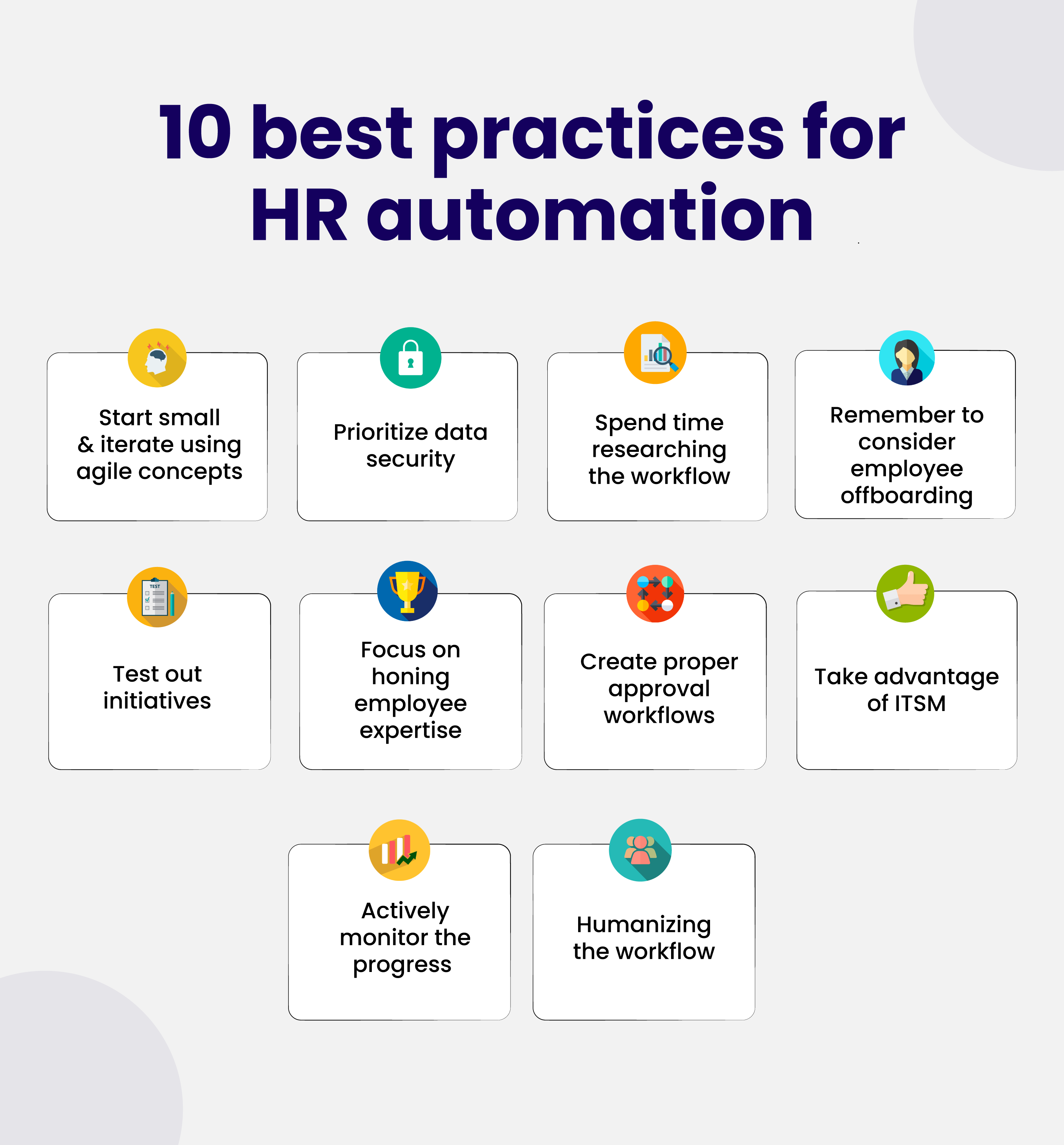Traditional HR operations like recruiting, onboarding, and payroll management are being transformed by emerging HR automation strategies. Organizations that have even marginally brought in automation in HR functions are seeing an increase in not just their productivity levels, but also the impact they have on the overall business resources like increased engagement.
In the absence of HR process automation, simple onboarding functions like enrolling new employees, coordinating between departments, and offering employees access to all necessary platforms prove to be a mammoth challenge, even for the most defined HR teams and organizations. Tasks might get delayed and conflicts can occur without good integration and communication between HR and IT teams.
A robust HR workflow automation is required to carry out all of this transformation.
In this blog, we will look at how you can transform your HR processes using these best practices.
What is HR processes automation?

HR process automation is the automation of operations such as onboarding, induction, training, invoicing, engagement, synchronization, and benefits management. The automation of such processes enables HR teams to enhance their efficiency and productivity. It allows HRs to boost their effectiveness. But more importantly, it helps HRs free up time for more complex duties like brainstorming, decision-making, and building interpersonal relationships with employees.
However, while the benefits of HR automation are plenty, organizations leveraging the technology are not as high, owing to some common myths around the same.
Some of them include:
- HR automation software is difficult to deploy
- HR process automation will result in the loss of employment
- There isn’t a lot of technical assistance for automation technologies
- Automation in HR is needed for only specific organizations
- Testing automation efficiency is tricky
- Automation can only be deployed in siloes
But these myths are only true when you lack the understanding of HR automation benefits and its capabilities. That’s why in this article, we’re discussing some of the best practices you need to keep in mind while automating HR processes.

10 best practices to follow while taking up an automation project
Lorem Ipsum is simply dummy text of the printing and typesetting industry. Lorem Ipsum has been the industrys standard dummy text ever since the 1500s, when an unknown printer took a galley of type and scrambled it to make a type specimen book.
1. Start small and iterate using agile concepts
Begin with implementing and testing an individual business unit and procedure and then expand and modernize the remaining HR operations. Start with some processes to figure out where the inefficiencies are and what might be automated to ease those trouble spots.
2. Keep focussing on increasing data security
HR documents and records are often confidential and critical to the success of your company. You might be obligated to save documentation from months or even decades earlier, and you’ll need it for inspections or future reference. So much of this data is recorded on one network in many outdated HR systems, and if that infrastructure fails, your data could be lost permanently.
When you employ an HR process automation tool that uses cloud services, your information will be stored securely. It’ll keep you safe even if there’s a crash, a power surge, a natural catastrophe, or whatever using cloud technologies.
Alternatively, when you don’t have such a robust system, you will need an IT infrastructure to keep your documents safe. This is not only an expensive alternative but is also prone to loopholes.
3. Spend your time researching to effectively apply the software
Implementing an HR automation strategy can dramatically disrupt your HR department if the automation tool isn’t a great fit. This can cause people to lose faith in technologies that can help them with these time-consuming chores. While learning and adapting may take a bit of time at first, try to get it right before you seek alternatives.
Allow instructional videos, films, or business experts to lead you and your employees through the process. When your HR management is running normally and you have more time to build your organization, you’ll be glad you didn’t want to rush the procedure.
Also, look into how similar organizations leverage HR process automation. Doing this analysis also helps to see use cases and benefits in real-time before implementing any changes.
4. Test out initiatives first
So, you’ve chosen the one simple task you’d like to automate first. Now, it’s better to dive into action. Should you invest in the extra effort to make sure the policy changes program is flawless before introducing it to staff members?
Not really, since perfecting a new program or procedure without testing it on the employees who would use it every day is not feasible in the long run.
That’s why it is important to make sure you roll out HR workflow automation initiatives in small, executable, understandable, and measurable stages.
5. Promote employee expertise
At this stage, it is important to also take note of your employee’s expertise. This includes how comfortable they are using digital tools and automation solutions, or getting to learning using the platform. Your employee expertise also has an impact on how effectively you’re able to employ HR automation and its effectiveness across all functions.
6. Continuously tweak workflows for an optimized approval process
Authorization barriers can restrict employees from contributing to their maximum capabilities in roles. The traditional back and forth of emails to submit requests, get clearances, and eventually get access to information, tools, etc, can take anywhere between a few days to weeks or even months; with instances wherein the conversation falls off midway, not getting bumped up unless the requirement arises again.
With the help of HR automation, you can create approval workflows across all functions and teams. This way the entire process is streamlined, removing permission hurdles by automating repetitive tasks such as request submission or even the parameters based on which approval is made.
7. Take advantage of ITSM to help your HR department
The concept that IT should be supplied as a commodity is at the heart of ITSM. This strategy can be quite beneficial to HR departments. HR, on the other hand, cannot just cut and paste what the IT department has accomplished.
IT can better determine which procedures should be computerized and automated to increase the HR squad’s effectiveness.
8. Actively monitor your automation
It’s important to note that building an HR automation strategy is a continuous process, not a one-time task. So, you’ll have to constantly watch the performance of HR automation and reflect on the questions and complaints that workers have that are rendering their journey difficult.
These conversations need to be around analytics and how they are proving to be beneficial for the company; whether the centralized dashboard is making it easy for personnel to manage the automation, and any technical difficulties that are occurring need to be addressed.
9. Humanizing the Workplace
Every company has a unique workforce, so you can’t treat all employees and managers the same. But that doesn’t mean you have to reinvent the wheel every time you have to deal with an employee issue. This is where automation in HR comes in handy.
They can help automate certain HR processes, but ensure there is a clear handoff between a virtual assistant and actual human resources so that a human can step in when a complex request arises. At the same time, you should focus on leveraging AI-based technologies, so that the automation isn’t perceived as mechanical. Instead, it appears more human and contextual.
You can use AI-based HR solutions like Leena AI to automate routine HR tasks such as employee onboarding, document management, FAQs, and more. This HR automation tool lets you create workflows that focus more contextual responses, making the interaction more conversational.
10. Remember to consider employee offboarding
Offboarding is a complicated subject for HR teams, whether an individual is departing voluntarily or not. There is a lot of repetition, like contacting the team, gathering corporate property, and adhering to legal requirements- all in a short amount of time.
Continued access to critical company data and clumsy offboarding expose a corporation to needless danger. Thus, offboarding should be simplified using HR automation software that streamlines the entire process, completing each of the tasks and compliances strategically.

What areas benefit most from HR automation strategies?
Recruitment
The HR team’s most critical job is recruiting and training new employees. Although no HR software can replace a trained recruitment specialist for people-focused duties like evaluating prospects, technology can play a significant role in this.
HR automation in the hiring process can help you narrow down a pool of qualified applicants to the most viable candidates and then choose people based on skills and attributes that are likely to succeed. This is important given that 87% of HR professionals have reported that they find it particularly difficult to hire qualified candidates due to the increasing skill gap.
Onboarding
This entails gathering documentation, signing contracts and providing new hires with tool authorization, addressing device requests, and overall assimilating them into the company.
During the onboarding process, HR process automation can assist with a gamut of tasks. This includes the option to manage contracts, gather e-signed documents, schedule orientation meetings, and give devices to employees without waiting for IT assistance. Furthermore, feedback can also be collected about the onboarding process to make it seamless for future employees.
Case management
HR case management is the method through which HR departments respond to employees’ doubts. In most cases, queries and proposals are sent to and processed through an HR case management system. This is a technical method of improving organizational efficiency. Employees can monitor and track when their issues are being addressed in such a framework.
A good HR case management software also assists you to tackle problems and convey information swiftly. It’s an investment that pays off in the form of employee retention and predictive modeling for strategic planning. It also contains important information about areas of dissatisfaction that can ultimately be taken care of due to automating the entire workflow once the employee raises a ticket.
Payroll management
Payroll automation systems collect information about an employee’s attendance and overtime. Measuring workdays, sick leave, and unpaid holidays manually create room for error. As a result, individuals are either underpaid or overpaid or experience delays in the same.
HR automation can improve the system by constantly monitoring and analyzing information, streamlining payments, and making data much easier to locate in the event of an internal audit or other reasons.
Document management
In traditional HR teams, their work revolved around the documentation process. This barred them from focusing on other aspects and creating an uplifting experience for the people.
With automated document management solutions, HR personnel can monitor the entire archive easily, freeing up time for other activities such as experience-driven onboarding, engagement activities, HR digital transformation, and strategizing for the year ahead.
Conclusion
HR automation will become the motivating factor behind many efforts as the modern organization evolves. Areas that will be focused on include linking talent to value, rendering the workforce more versatile, and focusing on strategic workforce planning, performance appraisal, and skills training. The decision your organization takes regarding HR process automation today will define the organization’s future tomorrow.






